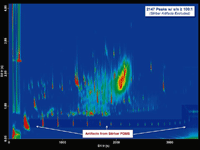Analysis of Aircraft Cabin Air by TD-GCXGC-TOFMS
A sample of ambient cabin air from a commercial airliner was collected by stir bar sorption extraction (SBSE) and analyzed by thermal desorption GCxGC-TOFMS.
Pete Stevens, LECO Corporation
A sample of ambient cabin air from a commercial airliner was collected by stir bar sorption extraction (SBSE) and analyzed by thermal desorption GC×GC-TOFMS. The cabin air is a mixture of recirculated cabin air and bleed air from the compressor stages of the aircraft's turbine engines. Volatile organic compounds in cabin air, tricresyl phosphate in particular, have been the subject of recent discussion.
Experimental Conditions
In this study, analyses were performed with a LECO Pegasus® 4D GC×GC-TOFMS system.
Primary Column: 10.0 m × 0.18 mm ID × 0.18 µm df DB-5
Secondary Column: 1.00 m × 0.10 mm ID × 0.10 µm df Rxi-17
Carrier Gas Flow: 1.2 mL/min Corrected Constant Flow
Oven Program: 30 °C 3 min 5 °C/min 295 °C 3 min
Column Offset: +10 °C
Modulator Offset: +15 °C
Modulation Period: 5 s
Hot Pulse Duration: 0.800 s
Source Temperature:200 °C
Acquisition Rate: 200 spectra/s
Acquisition Range: m/z 40 to 400
A GERSTEL Twister Desorption Unit (TDU) connected in-series with a GERSTEL CIS4 inlet was operated in Solvent Vent mode at 300 °C for 2 min and 50 mL/min flow. The CIS4 was held at –120 °C. The injection from the CIS4 to the column was Splitless at 300 °C and at column flow.
The sample was collected on a pair of 10 mm × 1.0 mm df PDMS GERSTEL Twister stir bars suspended from a wire scaffold in a 20 mL scintillation vial. The sample was collected by placing the apparatus ~8 cm from the overhead air vent operating at maximum flow for a period of 30 s.

Figure 1: A contour plot of the sample.
Results
The sample was data processed and 2147 peaks were found with a s/n ratio threshold ≥ 100:1. Tricresyl phosphate is an organophosphate that is a known neurotoxin that is present in the oil used in aviation turbine engines. Tricresyl phosphate was not found in the sample. Propanoic acid esters were a dominant feature.
Conclusions
The recent global outbreaks of SARS, influenza, and other highly contagious conditions have led commercial aircraft manufacturers and operators to equip aircraft ventilation systems with HEPA particle filtration. While HEPA filtration does provide a level of protection against particulate pathogens, it does not provide protection from chemical vapors present in the aircraft cabin and ventilation systems. The work presented here provides an example of a simple sampling technique for VOCs and SVOCs in a commercial aircraft cabin. This sample is complex and contains components over a wide range of volatilities and functionalities. When analyzed by GC×GC-TOFMS, the large number of individual components can be resolved and identified in a single analysis, providing an efficient means for the analyst to obtain a large amount of information about the sample with a minimum amount of effort. LECO's Pegasus 4D GC×GC-TOFMS system and ChromaTOF software are an excellent choice for the analysis of highly complex samples such as that demonstrated in this work.
LECO Corporation

3000 Lakeview Avenue, St. Joseph, MI 49085
tel. (269) 985-5496; fax (269) 982-8977
Website: www.leco.com

Separation of Ultra-Short and Long Chain PFAS Compounds Using a Positive Charge Surface Column
December 11th 2024A separation of ultra-short and long chain PFAS (C1-C18) is performed on a HALO®PCS Phenyl-Hexyl column along with a HALO®PFAS Delay column which demonstrates excellent retention for both hydrophilic and hydrophobic analytes.















